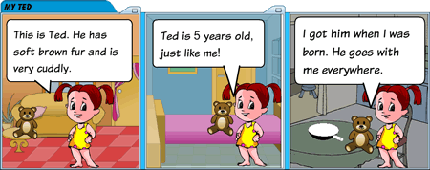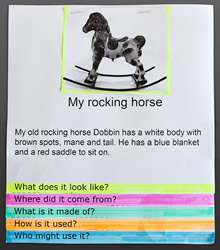Tasks
Students complete Task 1 and/or Task 2. In Task 1 students construct a multimodal text describing their favourite toy. In Task 2 they conduct an oral history interview with an older person they know, such as a grandparent, about toys and games when they were young.
Task 1
Each student constructs a multimodal text describing their favourite toy.
The Australian Curriculum classifies types of texts according to their purpose. Most history texts will be informative texts, 'which are culturally important in society and are valued for their informative content, as a store of knowledge and for their value as part of everyday life'.
The Australian Curriculum: History, General capabilities—Literacy states that 'Students develop literacy capability as they learn how to build historical knowledge and to explore, analyse, question, discuss and communicate historical information, concepts and ideas'.
Building descriptive language
Analyse an art work from the Web Gallery of Art.
For example, use an IWB to display an image of Children's Games by Bruegel.
- Describe an activity or game in the artwork and ask one student to locate it in the image. The student then finds another toy or game in the art work and describes it for others to identify.
- Use the 'detail' images of Children's Games to allow closer examination and description of the artwork.
If using IWB software, such as SMART Notebook, select the Spotlight tool or the Magnifier for focusing attention on details in the artwork.
Play Barrier games where students sit opposite one another with a barrier between them. They can be adapted for developing descriptive language. For example:
- one student holds an object and describes it to a student on the other side of a barrier who tries to identify the object
- one student holds an object while a student on the other side of a barrier asks questions to help them name the object.
Learning Activity 26 at Digital Literacy Learning Activities for the Early Phase outlines a digital barrier game that students can play to develop oral descriptive language skills.
Make a photographic record
Assist students to take photographs of their favourite toys. They might also wish to take photos of students with their toys.
Put the images on a computer or school server in a location that is accessible to the students.
Write a description
Assist students to write a description of their favourite toy.
The Writing a description (.pptx 94kB) PowerPoint presentation can be used to guide your students in developing their own description.
Slide 1 examines 'question words' or interrogative words that will assist students when describing their toy.
Slide 2 examines each paragraph to identify the information it contains. Talk about the purpose of the text.
Slide 3 allows scope for:
- further discussion of the purpose of the text
- discussing and identifying punctuation
- looking for words that represent people places and things (nouns and pronouns), happenings and states (verbs), qualities (adjectives) and details such as when, where and how (adverbs)
- re-reading and suggesting improvements to the text.
You could use the scaffold (.docx 16kB) or the TES worksheet Describe the toys to develop your students' knowledge and understanding of descriptive words. You must log in to access the worksheet.
Make a multimodal text
Assist students to make a multimodal text about their toy.
Multimodal texts combine language with other systems for communication. Students make a multimodal text using their description and the photographs that they took previously. They might need to take additional photographs.
Students could use a presentation tool such as ToonDoo, Microsoft PowerPoint or Microsoft Word to create their multimodal presentation. This might incorporate images, text and audio.
Using ToonDoo
You could ask students to begin their ToonDoo by choosing a horizontal layout with the number of boxes they wish to use. The example below is created in a horizontal layout with three boxes.

You could use this ToonDoo example, which describes a teddy bear, as a model for students' presentations.
The first box addresses the questions:
- What is the toy?
- What is Ted made of?
- What does Ted look like?
The second box addresses the question:
- How old is Ted?
The third box or slide addresses the questions:
- Where is Ted from?
- Where is Ted kept?
Read A teacher's guide to ToonDoo and sign up to start.
Using Microsoft PowerPoint
Students can create one or more PowerPoint slides if creating their multimodal text as a PowerPoint presentation. They might, for example, use three slides.
Slide 1 could address the questions:
- What is the toy?
- What is the toy made of?
- What does it look like?
Slide 2 could address the question:
- How old is the toy?
Slide 3 could address the questions:
- Where is the toy from?
- Where is it kept?
Students could include a reading of the text and a variety of photographs.
Using a flip book maker
Construct an individual or class flip book from the Read Write Think website.

When students create their own flip book they have the option to use drawing tools or print the flip book and place a photo or drawing of the object on the cover.
Further support and work samples of students' descriptive writing are available in Writing Fun (if you have access to Mathletics or Spelladrome websites). Select 'Description'.
Task 2
Students conduct an oral history interview (.docx 92kB) with their grandmother, grandfather or older member of the family to get their perspective on what toys and games they played with when they were young.
Help students to devise open-ended questions
Introduce the concept of open-ended questions.
Students use the think-pair-share strategy to devise two open-ended questions that they could ask an older member of the community to find out about the toys and games that were played a long time ago. Provide each pair with two question words such as how, when, where, why or what to guide their questions.
Bring the class together and compile the questions in this PowerPoint slide show (.pptx 52kB). Analyse each question and discuss if it is an open-ended question or a closed question and whether it would provide the information required. Students can use the compiled questions as a guide when they prepare their own interview.
Prepare students to conduct an oral history interview
Show students the guide for conducting an oral history interview (.docx 26kB). Read the steps with students focusing on the action verb in bold type.
You might:
- brainstorm ways to conduct an interview other than in person such as via Skype
- suggest ways of recording and sharing the interview such as using a video camera, an mp3 recorder, Audacity or VoiceThread
- talk about and role play ways to show your interest, verbally and non-verbally
- suggest students ask for more information when needed. They might ask ‘Can you tell me more about that?’
Students record their own interview questions on the Student interview (.docx 288kB) sheet. You could use these questions (.docx 21.7kB) to assist your students.
Assist students to conduct and present their oral history interview.